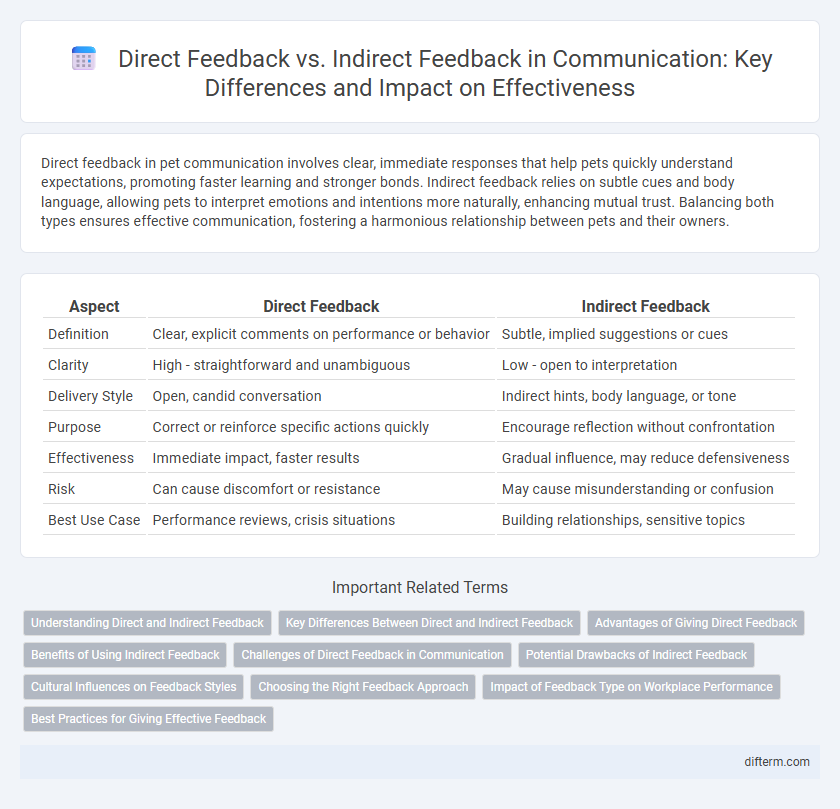Direct feedback in pet communication involves clear, immediate responses that help pets quickly understand expectations, promoting faster learning and stronger bonds. Indirect feedback relies on subtle cues and body language, allowing pets to interpret emotions and intentions more naturally, enhancing mutual trust. Balancing both types ensures effective communication, fostering a harmonious relationship between pets and their owners.
Table of Comparison
| Aspect | Direct Feedback | Indirect Feedback |
|---|---|---|
| Definition | Clear, explicit comments on performance or behavior | Subtle, implied suggestions or cues |
| Clarity | High - straightforward and unambiguous | Low - open to interpretation |
| Delivery Style | Open, candid conversation | Indirect hints, body language, or tone |
| Purpose | Correct or reinforce specific actions quickly | Encourage reflection without confrontation |
| Effectiveness | Immediate impact, faster results | Gradual influence, may reduce defensiveness |
| Risk | Can cause discomfort or resistance | May cause misunderstanding or confusion |
| Best Use Case | Performance reviews, crisis situations | Building relationships, sensitive topics |
Understanding Direct and Indirect Feedback
Direct feedback involves clear, explicit communication where the message is straightforward and unambiguous, facilitating immediate understanding and action. Indirect feedback relies on subtle cues, implications, or context, requiring recipients to interpret the underlying meaning, which can enhance politeness but risk miscommunication. Recognizing these feedback types improves interpersonal communication skills and fosters more effective dialogue in personal and professional settings.
Key Differences Between Direct and Indirect Feedback
Direct feedback involves clear, explicit, and straightforward communication, providing specific evaluations or suggestions without ambiguity. Indirect feedback is conveyed subtly, often through hints, body language, or suggestions, requiring interpretation to understand the message. The key difference lies in the clarity and immediacy of the content, with direct feedback promoting prompt action and indirect feedback preserving social harmony or minimizing confrontation.
Advantages of Giving Direct Feedback
Direct feedback fosters clear communication by providing specific, actionable insights that enhance performance and understanding. It reduces misinterpretations and encourages immediate improvements through straightforward, honest dialogue. This method builds trust and accountability, promoting a transparent and efficient feedback culture.
Benefits of Using Indirect Feedback
Indirect feedback fosters a supportive environment by allowing recipients to process information without feeling defensive, enhancing openness to improvement. It encourages reflection and self-assessment, leading to deeper understanding and long-term behavioral changes. This approach also helps maintain positive relationships by softening criticism and reducing potential conflicts in communication.
Challenges of Direct Feedback in Communication
Direct feedback in communication often presents challenges such as heightened emotional reactions and resistance from the receiver, which can hinder constructive dialogue. The blunt nature of direct feedback may lead to misunderstandings or defensiveness, reducing the effectiveness of the intended message. Overcoming these challenges requires skillful delivery and emotional intelligence to maintain clarity without offending the recipient.
Potential Drawbacks of Indirect Feedback
Indirect feedback can lead to misunderstandings and ambiguity, as the message may lack clarity and precise guidance, causing confusion in workplace communication. It often results in delayed responses or unresolved issues due to its subtlety, which may diminish the effectiveness of performance improvement efforts. Furthermore, indirect feedback may create a culture of uncertainty, reducing employee motivation and trust in leadership.
Cultural Influences on Feedback Styles
Direct feedback is often preferred in low-context cultures such as the United States and Germany, where clear and explicit communication promotes efficiency. In contrast, high-context cultures like Japan and China favor indirect feedback, emphasizing harmony and relationship preservation through subtle cues and nonverbal signals. Understanding these cultural influences on feedback styles enhances cross-cultural communication and reduces misunderstandings in international business environments.
Choosing the Right Feedback Approach
Choosing the right feedback approach depends on the context, relationship, and desired outcome. Direct feedback offers clarity and immediacy, enhancing understanding in high-stakes or performance-driven situations. Indirect feedback fosters a softer delivery, reducing defensiveness and maintaining harmony in sensitive or hierarchical environments.
Impact of Feedback Type on Workplace Performance
Direct feedback fosters clear understanding and immediate behavioral adjustments, significantly enhancing workplace performance by reducing ambiguity. Indirect feedback often softens the message but may lead to misinterpretation, delaying corrective actions and affecting productivity. Choosing the appropriate feedback type aligns communication style with organizational culture, ultimately influencing employee engagement and overall effectiveness.
Best Practices for Giving Effective Feedback
Direct feedback ensures clarity and immediacy by addressing specific behaviors or outcomes, enhancing understanding and actionable responses. Indirect feedback, often conveyed through suggestions or questions, encourages reflection and self-assessment, fostering a collaborative environment. Combining both methods strategically, tailored to the recipient's preference and situation, maximizes engagement and promotes continuous improvement.
direct feedback vs indirect feedback Infographic

 difterm.com
difterm.com